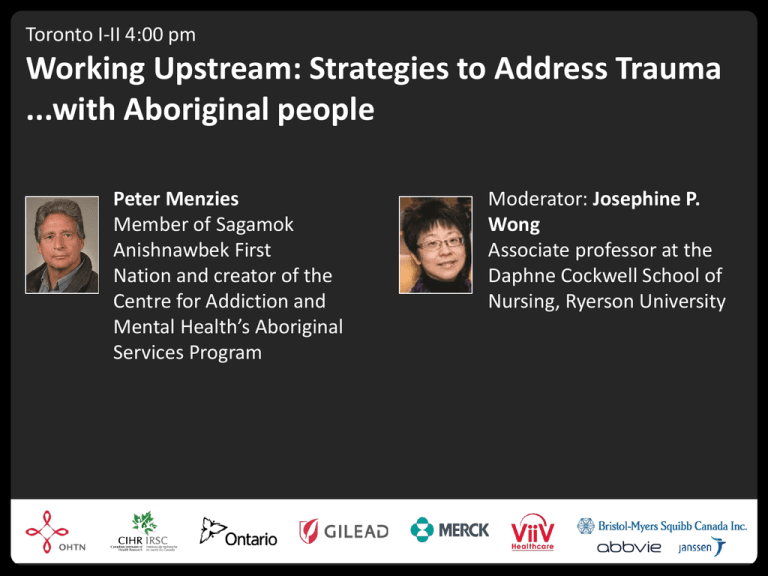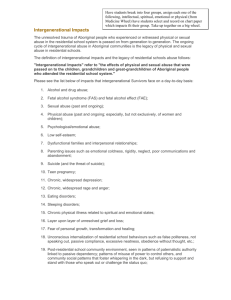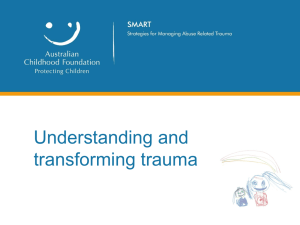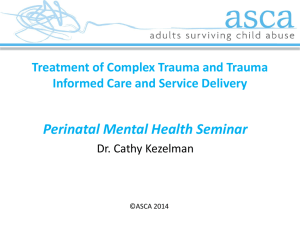Intergenerational Trauma - OHTN Research Conference
advertisement

Toronto I-II 4:00 pm Working Upstream: Strategies to Address Trauma ...with Aboriginal people Peter Menzies Member of Sagamok Anishnawbek First Nation and creator of the Centre for Addiction and Mental Health’s Aboriginal Services Program Moderator: Josephine P. Wong Associate professor at the Daphne Cockwell School of Nursing, Ryerson University Four Directions Therapeutic and Consulting Services Sagamok Anishnawbek First Nation Phone: 1 - 289 - 927- 3060 pm_menzies@hotmail.com HIV/AIDS: Intergenerational Trauma A Research Framework Monday, November 18, 2013 Understanding of intergenerational trauma Impact Conceptualization of practice and research Indian Act ◦ Residential Schools ◦ Child Welfare Societal ◦ Racism ◦ Discrimination ◦ Stereotype Set up and run primarily by churches on behalf of the federal government to replace Native families and communities traditions with European values The residential school policy was designed to lift Aboriginal peoples from their helpless ‘savage’ state to one of ‘self reliant civilization.’ To make Canada one community “…Aboriginal children were stripped of all their belonging, including any artifacts of their culture, their hair was cut and their clothing were replaced with institutional uniforms” (Mental health Profile for a sample of British Columbia Aboriginal survivors of the Canadian Residential School System (2003) By 1930, 75 per cent of First Nations children between the ages of 7 and 15 years were enrolled in one of 80 such schools across the country and in the 1940s, attendance was expanded to include Inuit children as well (Aboriginal People, Resilience and the Residential School Legacy, 2003) On individuals, families, communities and nations Many residents were denied love, cultural expression, and the loss of family and community experiences Many today experience personal crises including alcoholism, drug abuse, solvent abuse, depression, low self esteem, suicide, loneliness, family violence, unemployment and cultural identity Family values, parenting knowledge disruptive Community values, customs and behaviour lost Impact of Residential Schools First Nations survivors of residential schools are aged 40 and older. According to the Regional Health Survey, one-half of First Nations adults living on-reserve said their health and well-being had been negatively affected by the residential school experience, including isolation from family, verbal or emotional abuse, and loss of cultural identity (Regional Health Survey, 2004) Over 7 in 10 attendees (71.5%) had witnessed the abuse of others. Personal abuse was reported by many: sexual abuse (32.6%); physical abuse (79.2%); and verbal or emotional abuse (79.3%) (Regional Health Survey, 2004) Residential School survivors were not raised by their own families, the intergenerational transmission of family values, parenting knowledge and community behaviour has been lost (Payukotayno, 1988) The effects of apprehension on an individual Native child will often be much more traumatic than for his non-Native counterpart. Frequently, when the Native child is taken from his parents, he is also removed from a tightly knit community of extended family members and neighbors, who may have provided some support. In addition, he is removed from a unique, distinctive and familiar culture. The Native child is placed in a position of triple jeopardy (Royal Commission on Aboriginal Peoples, 1996) Like the Residential Schools where their parents, grandparents and great grandparents were sent, the foster care system created another generation of children who have been subjected to psychological, emotional, sexual and physical abuse. Isolation from their families and Aboriginal identity was intensified when some children were sent outside of Canada to the United States and Europe for adoption (Bagley, 1993) Suicide among First Nations people is 3 to 4 times that of the non-Aboriginals (Health Canada, 2003) Aboriginals account for 7.5 per cent of the 58,000 Canadians living with HIV and 9 per cent of all new HIV infections (The Public Health Agency of Canada, 2006) Alcohol (73%) and drug abuse (59%) were considered problems in First Nation communities (Health Canada, 2003) Diabetes in Aboriginal populations is 3-5 times higher than that in the general population and the rates are growing (Ho, 2006) Rates of concurrent disorders suspected to be even higher (70%?) than in general population (30-60%?) (Presentation to the First Nations and Inuit Mental Wellness Advisory Committee June 9 -10, 2005) Ontario First Nations Mental Health & Addictions Childhood Abuse Alcohol abuse Sexual Abuse Illicit drugs Cultural Loss Prescription abuse Domestic Violence Inhalants Grief / Loss Self-Esteem Issues History of Violence/ Trauma FASD (Ontario Region First Nations Addictions Service Needs Assessment, 2010) The Indian Act also contributed to personal psychological trauma, denying many children the right of being identified as members of their birth family and community. This personal trauma has been compounded by the fact that several generations of children have been directly affected by the same events experienced by older family members Residential schools and child welfare policies severed ties between the individual, family and community. Forced to adopt the values of another culture that derided their own belief system, the children were left in a cultural vacuum: relating neither to mainstream culture nor their own community For many Aboriginal people, the connection between spiritual, emotional, physical and mental well-being has been disrupted. Child welfare studies describe the long-term effects of removing Aboriginal children from their birth family and placing them in nonAboriginal homes (Couchi & Nabigon, 1994; Frideres, 1998; Locust, 1999) As adults, former residential school students and child welfare system survivors have demonstrated symptoms of anxiety disorders, high rates of alcohol and substance abuse, depression, suicide, and low self esteem that are significantly higher than that of the general population (Beisner & Attneave, 1982; Gagne, 1998; Hodgson, no date; Saltshan Institute Society, 1991) Intergenerational Trauma The Aboriginal Healing Foundation (2001) has noted that: “Many passed the abuse suffered on to their children, thereby perpetuating the cycle of abuse and dysfunctional arising from the Residential School System. Subsequent generation of children was left with the consequences of what happened to their parents and grandparents. They grew up without the opportunity to learn their language, to have traditions and cultural knowledge passed down to them, or to be apart of a strong and healthy family and community” (p.7) “If we do not deal with our trauma, we inadvertently hand it down to the next generation. We often take out our pain and hurt on those we love the most – which is ourselves, and those closest to us – our family and friends. So, intergenerational trauma is trauma that is passed down behaviourally to the next generation: if we’re angry and act angry all the time to others, our kids will think that’s normal and do the same. If we ignore each other and deprive each other of love and affection in our relationships, our kids see and feel that deprivation of love and might think it’s normal” (Phillips, 1999) Homeless Intergenerational Trauma Model Intergenerational Trauma Indian Act NATION INDIVIDUAL Lack of a sense of “belonging”, identification or affiliation with a specific family, community, culture, or nation Feeling of “abandonment” by caregivers Limited or no information about one’s culture of birth including language, customs, belief systems, spirituality One or more “flight” episodes as a youth from a caregiver environment Inability to sustain personal or intimate relationships Being present oriented, not future oriented Limited education and/or employment history Involvement with the mental health system History of substance misuse History of involvement with the criminal justice system precipitated by substance misuse Low self esteem Popularization of negative stereotypes through mainstream media Social policies that perpetuate colonialism of Aboriginal people on an individual, family and community basis Lack of support for holistic programs and services targeting Aboriginal needs Lack of support for community selfdetermination Homelessness Intergenerational Trauma COMMUNITY Child Welfare Unconcealed alcohol and/or drug misuse among community members Lack of cultural opportunities including transmission of language skills, history, traditional values, and spirituality Unwillingness to “reclaim” community members Low levels of social capital (Putnam, 2000), including trust, reciprocal helping relations and social engagement Intergenerational Trauma FAMILY Chronic or episodic family violence including physical, sexual, emotional, and/or verbal abuse of children by adults in the household Lack of emotional bonding between parents, siblings and extended family members Denial of cultural heritage by older family members Unconcealed and rampant alcohol and drug misuse that crosses generations Perpetuation of negative stereotypes within the family of birth or caregiver environment Irregular contact or the absence of contact with caregiver family members Traditional Aboriginal Culture Residential Schools (Menzies, 2007) Transmission of Intergenerational Trauma “Psychodynamic: contends that trauma is passed to the child through the unconscious absorption of repressed and unintegrated trauma experiences Sociocultural models focus on the direct impact the parents and social environment have on the child, as the child learns vicariously through observation The family systems model focuses on communication between generations and the degree of enmeshment that occurs The transmission of trauma is frequently noted in reference to untreated or unspoken survivor trauma, as it may pass to future generations if not treated (Kidron, 2003) (Denham, p397, 2008) “In other words, an individual focused approach to understanding trauma in the context of the peoples of Canada’s First Nations misses the fact that traumatic impacts are rooted not only in the specific experiences of any individual’s unique life story and experiences, but also that traumatic impacts are structured by the historical legacy and contemporary realities of social inequalities” (Haskell et al, 2009, p49) (Gagne, 1998) (Gagne, 1998) Foundation Process ◦ Resiliency ◦ Strengthen based ◦ Community/Tribal driven and ownership, including worldview and tradtions Meaning ◦ First Nation ◦ Tribal









